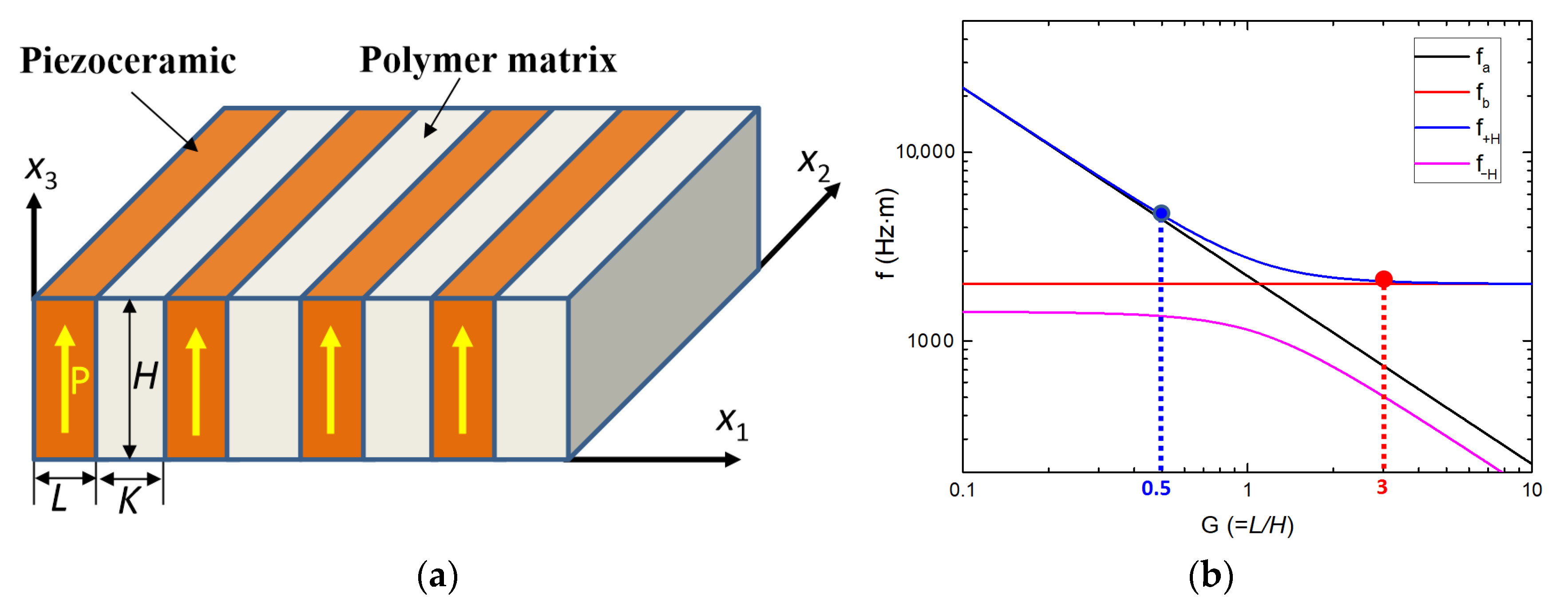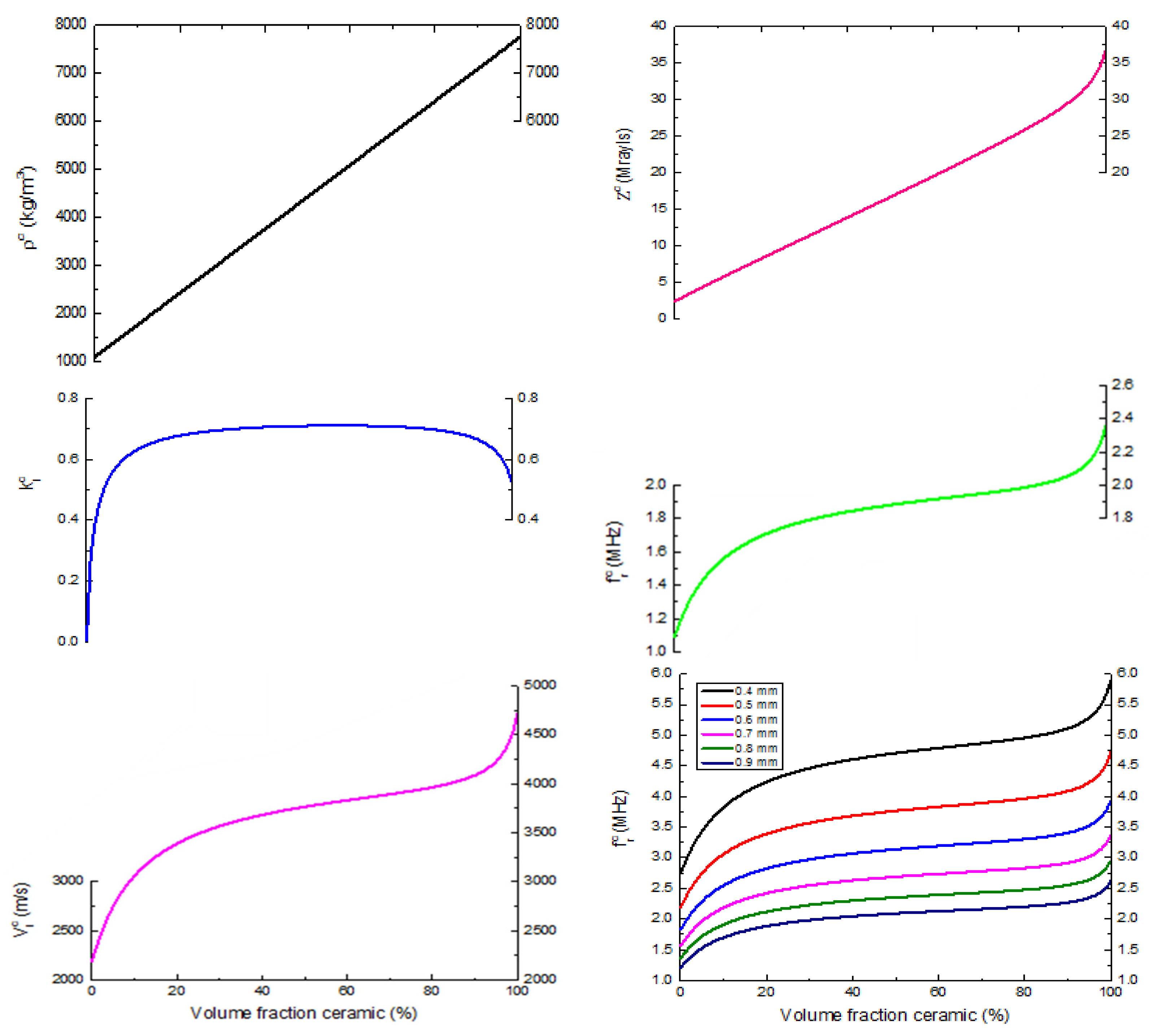Characteristics of a 2-2 Piezoelectric Composite Transducer Made by Magnetic Force Assembly
Abstract
:1. Introduction
2. Theoretical Design
2.1. Design of Active Piezoelectric Material Dimension
2.2. Design of 2-2 Composite Transducer
3. Fabrication
4. Results and Discussion
5. Conclusions
Funding
Institutional Review Board Statement
Informed Consent Statement
Data Availability Statement
Acknowledgments
Conflicts of Interest
References
- Cochran, S.; Parker, M.; Marin-Franch, P. Ultrabroadband Single Crystal Composite Transducers for Underwater Ultrasound. Proc. IEEE Ultrason. Symp. 2005, 1, 231–234. [Google Scholar] [CrossRef]
- Marin-Franch, P.; Pettigrew, I.; Parker, M.; Kirk, K.J.; Cochran, S. Piezocrystal-Polymer Composites: New Materials for Transducers for Ultrasonic NDT. Insight Non-Destr. Test. Cond. Monit. 2004, 46, 653–657. [Google Scholar] [CrossRef]
- Ebbini, E.S. Self-Guided Ultrasound Phased Arrays for Noninvasive Surgery. Proc. SPIE 2001, 4247, 30–40. [Google Scholar]
- Kim, J.; Li, S.; Kasoji, S.; Dayton, P.A.; Jiang, X. Phantom Evaluation of Stacked-Type Dual-Frequency 1-3 Composite Transducers: A Feasibility Study on Intracavitary Acoustic Angiography. Ultrasonics 2015, 63, 7–15. [Google Scholar] [CrossRef] [PubMed]
- Sun, R.; Wang, L.; Zhang, Y.; Zhong, C. Characterization of 1-3 Piezoelectric Composite with a 3-Tier Polymer Structure. Materials 2020, 13, 397. [Google Scholar] [CrossRef] [PubMed] [Green Version]
- Newnham, R.E.; Skinner, D.P.; Cross, L.E. Connectivity and Piezoelectric-Pyroelectric Composites. Mater. Res. Bull. 1978, 9, 198–200. [Google Scholar] [CrossRef]
- Wang, W.; Or, S.W.; Yue, Q.; Zhang, Y.; Jiao, J.; Leung, C.M.; Zhao, X.; Luo, H. Ternary Piezoelectric Single-Crystal PIMNT Based 2-2 Composite for Ultrasonic Transducer Applications. Sens. Actuators A Phys. 2013, 196, 70–77. [Google Scholar] [CrossRef]
- Xu, D.; Cheng, X.; Huang, S.; Jiang, M. Electromechanical Properties of 2-2 Cement Based Piezoelectric Composite. Curr. Appl. Phys. 2009, 9, 816–819. [Google Scholar] [CrossRef]
- Lopatin, S.; Lopatina, I.; Lisnevskaya, I. Magnetoelectric PZT/Ferrite Composite Materials. Ferroelectrics 1994, 162, 63–68. [Google Scholar] [CrossRef]
- McNulty, T.F.; Mohammadi, F.; Bandyopadhyay, A.; Shanefield, D.J.; Danforth, S.C.; Safari, A. Development of a Binder Formulation for Fused Deposition of Ceramics. Rapid Prototyp. J. 1998, 4, 144–150. [Google Scholar] [CrossRef] [Green Version]
- Zhang, Y.; Jiang, Y.; Lin, X.; Xie, R.; Zhou, K.; Button, T.W.; Zhang, D. Fine-Scaled Piezoelectric Ceramic/Polymer 2-2 Composites for High-Frequency Transducer. J. Am. Ceram. Soc. 2014, 97, 1060–1064. [Google Scholar] [CrossRef]
- Li, K.; Zeng, D.W.; Yung, K.C.; Chan, H.L.W.; Choy, C.L. Study on Ceramic/Polymer Composite Fabricated by Laser Cutting. Mater. Chem. Phys. 2002, 75, 147–150. [Google Scholar] [CrossRef]
- Yin, J.; Lukacs, M.; Harasievvicz, K.; Foster, S. Ultra-Fine Piezoelectric Composites for High Frequency Ultrasonic Transducers. Proc. IEEE Ultrason. Symp. 2004, 3, 1962–1965. [Google Scholar] [CrossRef]
- Or, S.W.; Chan, H.L.W. Mode Coupling in Lead Zirconate Titanate/Epoxy 1-3 Piezocomposite Rings. J. Appl. Phys. 2001, 90, 4122–4129. [Google Scholar] [CrossRef] [Green Version]
- Qi, W.; Cao, W. Finite Element Analysis and Experimental Studies on the Thickness Resonance of Piezocomposite Transducers. Ultrason. Imaging 1996, 18, 1–9. [Google Scholar] [CrossRef] [PubMed]
- Smith, W.A.; Auld, B.A. Modeling 1–3 Composite Piezoelectrics: Thickness-Mode Oscillations. IEEE Trans. Ultrason. Ferroelectr. Freq. Control 1991, 38, 40–47. [Google Scholar] [CrossRef] [PubMed]
- Kim, T.; Kim, J.; Jiang, X. Transit Time Difference Flowmeter for Intravenous Flow Rate Measurement Using 1-3 Piezoelectric Composite Transducers. IEEE Sens. J. 2017, 17, 5741–5748. [Google Scholar] [CrossRef]




| k33 | Center Freq. | Acoustic Impedance(Z) | Bandwidth |
|---|---|---|---|
| >60% | 5 MHz | <20 MRayl | >65% |
| PZT-5H | Epoxy | |
|---|---|---|
| C11E (1010 N/m2) | 15.1 | 0.53 |
| C12E (1010 N/m2) | 9.80 | 0.31 |
| C13E (1010 N/m2) | 9.60 | - |
| C33E (1010 N/m2) | 12.4 | - |
| ρ (kg/m3) | 7750 | 1100 |
| ε33s/ε0 | 1700 | 4 |
| k33 (%) | 75 | - |
| kt (%) | 52 | - |
| Backing | Active | Matching_0 | Matching_1 | |
|---|---|---|---|---|
| Material | E-solder | PZT-5H composite | EPO-TEK | PayleneC |
| Longitudinal velocity (m/s) | 1850 | 3833 | 2700 | 2770 |
| ρ (kg/m3) | 3200 | 5090 | 1670 | 1140 |
| Acoustic impedance (MRayl) | 5.92 | 19.5 | 4.51 | 3.16 |
Publisher’s Note: MDPI stays neutral with regard to jurisdictional claims in published maps and institutional affiliations. |
© 2022 by the author. Licensee MDPI, Basel, Switzerland. This article is an open access article distributed under the terms and conditions of the Creative Commons Attribution (CC BY) license (https://creativecommons.org/licenses/by/4.0/).
Share and Cite
Kim, T. Characteristics of a 2-2 Piezoelectric Composite Transducer Made by Magnetic Force Assembly. Crystals 2022, 12, 740. https://doi.org/10.3390/cryst12050740
Kim T. Characteristics of a 2-2 Piezoelectric Composite Transducer Made by Magnetic Force Assembly. Crystals. 2022; 12(5):740. https://doi.org/10.3390/cryst12050740
Chicago/Turabian StyleKim, Taeyang. 2022. "Characteristics of a 2-2 Piezoelectric Composite Transducer Made by Magnetic Force Assembly" Crystals 12, no. 5: 740. https://doi.org/10.3390/cryst12050740
APA StyleKim, T. (2022). Characteristics of a 2-2 Piezoelectric Composite Transducer Made by Magnetic Force Assembly. Crystals, 12(5), 740. https://doi.org/10.3390/cryst12050740





